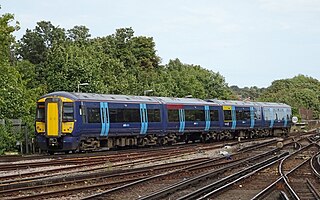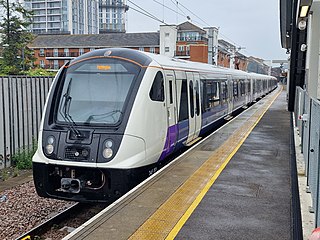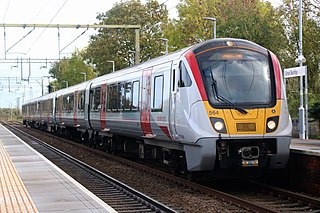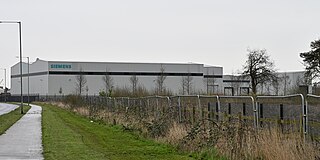
A diesel multiple unit or DMU is a multiple-unit train powered by on-board diesel engines. A DMU requires no separate locomotive, as the engines are incorporated into one or more of the carriages. Diesel-powered single-unit railcars are also generally classed as DMUs. Diesel-powered units may be further classified by their transmission type: diesel–mechanical DMMU, diesel–hydraulic DHMU, or diesel–electric DEMU.

Metro-Cammell, formally the Metropolitan Cammell Carriage and Wagon Company (MCCW), was an English manufacturer of railway carriages, locomotives and railway wagons, based in Saltley, and subsequently Washwood Heath, in Birmingham. The company was purchased by GEC Alsthom in May 1989; the Washwood Heath factory closed in 2005 and was demolished in early 2019.

British Rail Engineering Limited (BREL) was the railway systems engineering subsidiary of British Rail.

The British Rail Class 375 Electrostar is an electric multiple unit train that was built by Bombardier Transportation at Derby Litchurch Lane Works, from 1999 to 2005. The class form part of the Electrostar family of units, which also includes classes 357, 376, 377, 378, 379 and 387, the most numerous type of EMU introduced since the privatisation of British Rail.

The British Rail Class 377 Electrostar is a British dual-voltage electric multiple unit passenger train (EMU) built by Bombardier Transportation on its Electrostar platform at Derby Litchurch Lane Works from 2001 to 2014.

Adtranz was a multi-national rail transportation equipment manufacturer with facilities concentrated in Europe and the US. The company, legally known as ABB Daimler-Benz Transportation, was created in 1996 as a joint venture between ABB and Daimler-Benz to combine their rail equipment manufacturing operations. In 1999, DaimlerChrysler bought ABB's shares and changed the company's official name to DaimlerChrysler Rail Systems. The company was acquired by Bombardier in 2001, which merged it into its Bombardier Transportation division, which became the largest rail equipment manufacturer in the world at the time, and was ultimately acquired by Alstom in 2021.

The Derby Works comprised a number of British manufacturing facilities designing and building locomotives and rolling stock in Derby, England. The first of these was a group of three maintenance sheds opened around 1840 behind Derby station. This developed into a manufacturing facility called the Midland Railway Locomotive Works, known locally as "the loco" and in 1873 manufacturing was split into locomotive and rolling stock manufacture, with rolling stock work transferred to a new facility, Derby Carriage & Wagon Works.
Bombardier Transportation was a Canadian-German rolling stock and rail transport manufacturer, with headquarters in Berlin, Germany. It was one of the world's largest companies in the rail vehicle and equipment manufacturing and servicing industry. Bombardier Transportation had many regional offices, production and development facilities worldwide. It produced a wide range of products including passenger rail vehicles, locomotives, bogies, propulsion and controls. In February 2020, the company had 36,000 employees, and 63 manufacturing and engineering locations around the world. Formerly a division of Bombardier Inc., the company was acquired by French manufacturer Alstom on 29 January 2021.

Crewe Works is a British railway engineering facility located in the town of Crewe, Cheshire. The works, which was originally opened by the Grand Junction Railway in March 1843, employed around 7,000 to 8,000 workers at its peak. In the 1980s much of the engineering works were closed. Most of the site has been redeveloped, but the remaining parts are owned and operated by Alstom.

Glasgow Works, formerly the St Rollox Works, is a railway rolling stock heavy maintenance and repair works established in the 1850s in the Glasgow district of Springburn by the Caledonian Railway Company, and known locally as 'the Caley'.

The Bombardier Electrostar is a family of electric multiple-unit (EMU) passenger trains manufactured by Bombardier Transportation at their Derby Litchurch Lane Works in England between 1999 and 2017. It has become the most common new EMU type in the United Kingdom since the privatisation of British Rail with a number of variants. Electrostar trains are most common on high-volume suburban commuter routes around London; and on mainline services from London south to Surrey and the south coast, east to Essex, and north to Cambridge and Stansted Airport.

The British Rail Class 172 is a British diesel multiple unit (DMU) passenger train from the Turbostar family, built by Bombardier Transportation's Derby Litchurch Lane Works for use on inner-suburban passenger services. The class is currently operated by West Midlands Railway.

The British Rail Class 379 Electrostar is an electric multiple unit (EMU) passenger train which was designed and built by Bombardier Transportation. The trains are part of the company's extensive Electrostar family.

The Alstom Aventra is a family of electric multiple unit (EMU) passenger trains produced at Derby Litchurch Lane Works in the United Kingdom, originally by Bombardier Transportation and later by Alstom, as a successor to the Bombardier Electrostar. A large proportion of its design is based on the Electrostar, adding new technologies and achieving compliance with more stringent requirements and operator demands.

The British Rail Class 345 Aventra is a fleet of electric multiple unit passenger trains built by Bombardier Transportation for use on London's Elizabeth line. Part of Bombardier's Aventra family of trains, the contract for their delivery was awarded as part of the Crossrail project in February 2014. A total of 70 nine-car units – each able to carry 1,500 passengers – were constructed in Derby between 2015 and 2019, at a cost of over £1 billion. The first unit entered service on 22 June 2017.

The Holgate Road carriage works was a railway carriage manufacturing factory in the Holgate area of York, England.

The British Rail Class 720 Aventra is a class of electric multiple unit (EMU) passenger train designed and produced by the rolling stock manufacturer Bombardier Transportation and Alstom. The Class 720 is operated by both Greater Anglia and c2c.

The British Rail Class 730 Aventra is a type of electric multiple unit passenger train built by Alstom for West Midlands Trains. Two separate batches of the fleet were built; 48 three-car units and 36 five-car units.

Siemens Goole is a train factory located in Goole, East Riding of Yorkshire, England. Siemens Mobility assessed several sites in the United Kingdom before settling on Goole with an intent to build the plant if it were successful in gaining orders for new rolling stock. After a June 2018 announcement that Siemens had won the bid to build 94 London Underground New Tube for London trains for the Piccadilly line of the London Underground, Siemens confirmed it would go ahead with building the factory, though this was then subject to further delays as other rolling stock companies objected to Siemens being given the contract.






















